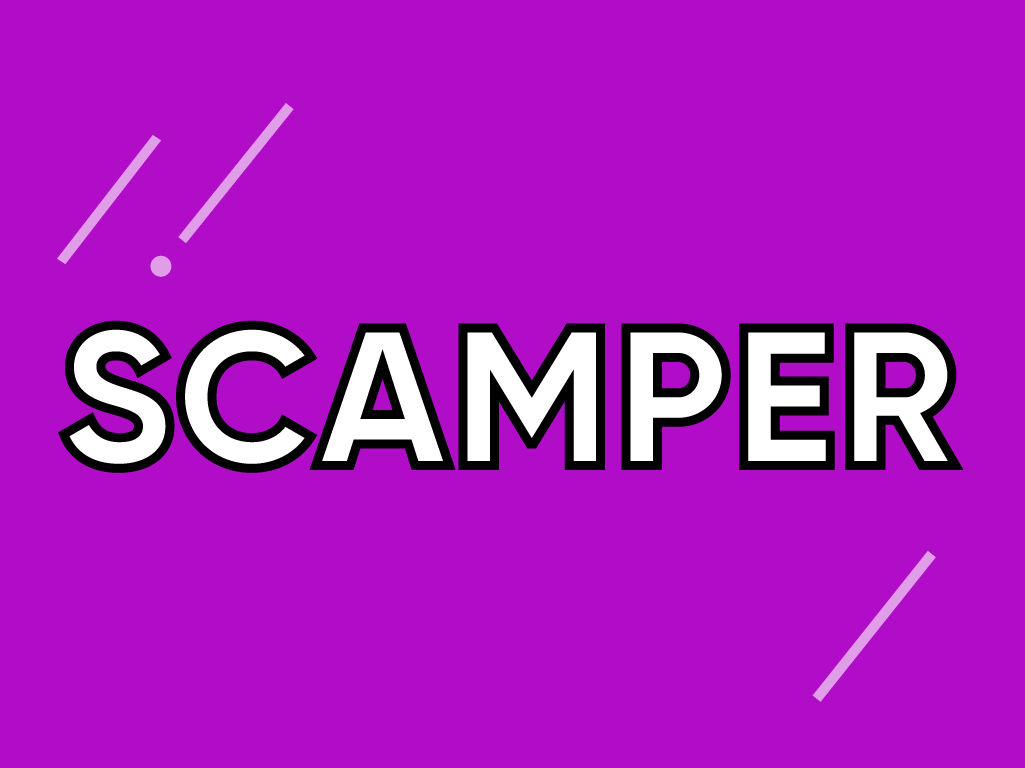It can often be difficult to come up with new ideas when you’re trying to develop or improve a product or service.
This is where creative brainstorming techniques like SCAMPER can help. This tool helps you generate ideas for new products and services by encouraging you to think about how you could improve existing ones.
SCAMPER refers to a series of thought sparkers or provocations which help you to innovate on an existing product, service or situation by looking through different lenses. There are seven provocation lenses in the SCAMPER method:
- Substitute
- Combine
- Adapt
- Modify
- Put to another use
- Eliminate
- Reverse
We’ve provided a series of questions within each of the lenses above to help guide your ideation needs across values, benefits, services, touch points, product attributes, pricing, markets and essentially any other related aspect you might require.
How to use or facilitate:
- Grab a pen and download the SCAMPER Worksheet via the link at the left of this page.
- If using a blank sheet of paper, draw 7 separate boxes and label each with “Substitute,” “Combine,” “Adapt,” “Modify,” “Put to another use,” “Eliminate,” and “Reverse.”
- To use the SCAMPER technique, first state the problem you’d like to solve or the idea you’d like to develop. It can be anything: a challenge in your personal life or business; or maybe a product, service or process you want to improve. After pinpointing the challenge, it’s then a matter of asking questions about it using the SCAMPER checklist to guide you.
- In each of the 7 boxes you’ve created, begin to answer the following questions:
Substitute
- What can I substitute to make an improvement?
- How can I substitute the place, time, materials or people?
- Can I replace someone involved?
- Can I change the rules?
- Should I change the name?
- Can I use other ingredients or materials?
- Can I use other processes or procedures?
- Can I use this idea for other projects?
Combine
- What ideas, materials, features, processes, people, products, or components can I combine?
- What can I combine so as to maximize the number of uses?
- What can I combine in order to lower the costs of production?
- Which materials could I combine?
- Where can I build synergies?
Adapt
- Which part of the product or process could I change?
- Could I change the characteristics of a component?
- Can I seek inspiration in other products or processes, but in a different context?
- Does the history offer any solutions?
- Which ideas could I adapt, copy, or borrow from other people?s products?
- What processes should I adapt?
- Can I adapt the context or target group?
Modify
- How can I change the product or process entirely?
- What can I magnify or make larger?
- What can I tone down or delete?
- Could I exaggerate or overstate buttons, colours, size??
- Could I grow the target group?
- Can I increase its speed or frequency?
- Can I add extra features?
- How can I add extra value?
Put to another use
- What else can it be used for?
- How would a child use it??an older person?
- How would people with different disabilities use it?
- Which other target group could benefit from this product?
- What other kind of user would need or want my product?
- Can it be used by people other than those it was originally intended for?
- Are there new ways to use it in its current shape or form?
Eliminate
- What can I remove without altering its function?
- Can I reduce time or components?
- What would happen if I removed a component or part of it?
- Can I reduce effort?
- Can I cut costs?
- How can I simplify it?
- What?s non-essential or unnecessary?
- Can I eliminate the rules?
- Can I make it smaller?
Reverse
- What if I revert or change order of the process? Do it the other way around?
- What can I rearrange in some way ? can I interchange components, the pattern, or the layout?
- Can I change the pace or schedule?
5. This is now your roadmap for taking your existing products, services, values, and any other assessments to the next level, refreshed and reborn.
The Takeaway:
Ideation, innovation, and fresh infusion of thought don’t have to come from a blank slate. By using your existing assets and adjusting, replacing, modifying, or just seeing them in a different light





